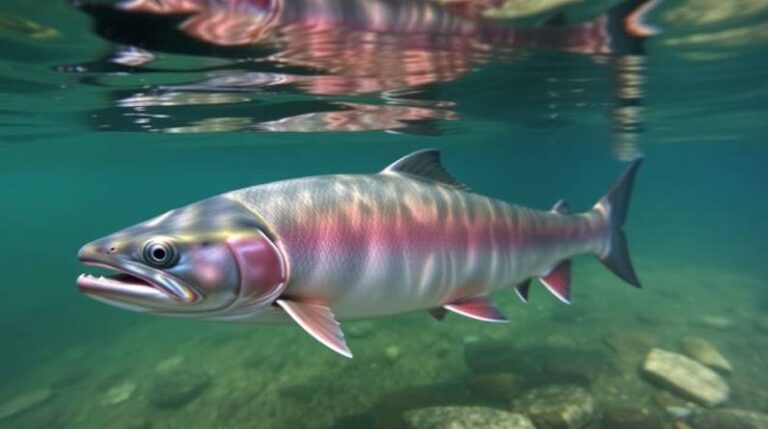Sockeye salmon (Oncorhynchus nerka)—often referred to as red salmon, blueback, or kokanee—stand out not just for their brilliant color and rich flavor, but also for their critical ecological role and extraordinary life cycle. While much has been said about their migration patterns and commercial value, this article dives deeper into how sockeye salmon uniquely bridge ecosystems, support biodiversity, and serve as a bellwether for environmental health.
What Is Sockeye Salmon?
Sockeye salmon are a species of Pacific salmon native to the Northern Pacific Ocean and rivers flowing into it. Their name, an anglicization of the Halkomelem word suk-kegh (“red fish”), reflects their vivid red appearance during spawning.
Key Characteristics:
- Scientific Name: Oncorhynchus nerka
- Size:5 to 2.5 feet (wild); kokanee ≤ 1.2 feet
- Weight: 4 to 15 pounds
- Coloration: Blue-silver at sea; red body and green head in spawning phase
- Lifespan: 4 to 5 years (typically)
The Sockeye Salmon Life Cycle: A Natural Odyssey
Anadromous Behavior
Sockeye salmon are anadromous, meaning they are born in freshwater, migrate to the ocean, and return to freshwater to spawn. This epic migration can span over 1,000 miles and thousands of feet in elevation gain.
Stages of the life cycle:
- Egg: Laid in freshwater gravel beds (redds)
- Alevin: Hatch in winter, survive on yolk sac
- Fry: Emerge in spring, feed on zooplankton
- Smolt: Adapt to saltwater and migrate to sea
- Adult: Spend 2–3 years feeding in the ocean
- Spawner: Return to freshwater, reproduce, and die
Kokanee, a landlocked form, complete this cycle entirely in freshwater lakes.
Sockeye Salmon’s Role in Ecosystem Health
Sockeye are not just fish; they are nutrient transporters. After spawning, their carcasses decompose, enriching freshwater ecosystems with nitrogen and phosphorus. These nutrients benefit:
- Aquatic insects and fry
- Riparian vegetation
- Birds and mammals (e.g., bears, eagles, wolves)
A single salmon’s journey brings marine nutrients far inland, fertilizing entire watersheds.
Ecological Keystone Species
Sockeye salmon support over 130 species, from microorganisms to megafauna. Removing them would disrupt entire food webs.
Sockeye vs. Atlantic Salmon: A Nutritional and Environmental Contrast
| Feature | Wild Sockeye Salmon | Farmed Atlantic Salmon |
| Color | Naturally red (astaxanthin) | Dyed pink using synthetic additives |
| Flavor | Bold, meaty, rich | Mild, fatty, less flavorful |
| Diet | Wild plankton, krill, shrimp | Corn- and soy-based pellets |
| Omega-3/Omega-6 | High omega-3, low omega-6 | High omega-6, lower omega-3 |
| Environment | Wild-caught, low-impact | Farm-raised, pollutes ecosystems |
| Sustainability | Highly sustainable (Alaska) | Often controversial, less sustainable |
Farmed Atlantic salmon now makes up 70% of the global market, but this comes with environmental costs—pollution, disease, and even genetic interference with wild stocks.
Culinary Brilliance: Why Chefs Love Sockeye
Sockeye’s rich color and bold taste make it a top choice in kitchens. Its lean flesh cooks faster than farmed salmon and works well with strong flavors.
Popular Cooking Methods:
- Grilled: Enhances the smoky undertones
- Baked with Herbs: Complements the fish’s robust profile
- Sashimi or Ceviche: Highlights its texture and freshness
Tip: Always reduce cooking time compared to farmed salmon recipes due to lower fat content.
A Cultural and Economic Powerhouse
Sockeye salmon is deeply woven into the heritage of Indigenous peoples along the Pacific Rim. For thousands of years, it has been:
- A dietary staple
- A ceremonial symbol
- A bartering resource
Modern Significance
Bristol Bay, Alaska hosts the world’s largest sockeye run, producing over 30 million fish annually. In 2022, sockeye salmon accounted for 19% of total Pacific salmon harvests globally.
Emerging Threats and Conservation Challenges
Habitat Loss
Urban development and damming have decimated runs in the Columbia Basin, Idaho, and parts of Oregon.
Climate Change
Rising river temperatures accelerate energy depletion during migration. Warmer oceans shift plankton availability, impacting diet quality.
Genetic Bottlenecks
Interbreeding between wild and escaped farmed salmon can reduce genetic fitness and increase disease susceptibility.
Sockeye Salmon as Climate Indicators
Sockeye salmon serve as real-time indicators of ecosystem shifts due to climate change. Their health and population trends reveal:
- River temperature fluctuations
- Ocean nutrient cycles
- Predator-prey dynamics
Case Study: Columbia River Sockeye Rebound
Despite dire forecasts, 2010 saw 300,000+ sockeye pass the Bonneville Dam, tripling expectations due to:
- Cooler North Pacific temperatures
- Strong plankton blooms
This shows that sockeye population trends mirror environmental recovery or stress faster than most species.
Tips for Buying and Enjoying Sockeye Responsibly
What to Look For:
- Label: “Wild-caught Alaskan Sockeye”
- Color: Deep red flesh (natural, not dyed)
- Texture: Firm, dense
Trusted Retailers:
- Wild Alaskan Company
- Bristol Bay-certified suppliers
- Direct-from-fisher programs
Final Thoughts: Why Sockeye Salmon Matters
Sockeye salmon are far more than just food—they are guardians of biodiversity, indicators of planetary health, and symbols of ecological resilience. Their survival reflects the success or failure of conservation, sustainable fishing, and climate action.
By choosing sockeye salmon, we are not just selecting a superior culinary experience—we are investing in a food system rooted in natural balance, Indigenous knowledge, and environmental stewardship.
Frequently Asked Questions (FAQ)
What is sockeye salmon?
Sockeye salmon (Oncorhynchus nerka) is a species of Pacific salmon known for its deep red flesh, rich flavor, and anadromous life cycle from rivers to the ocean.
Why is sockeye salmon red?
Its red color comes from astaxanthin, a natural antioxidant found in its diet of krill and plankton.
Is sockeye salmon healthier than Atlantic salmon?
Yes. Wild sockeye is leaner, higher in omega-3s, and free of synthetic dyes or additives used in farmed Atlantic salmon.
What’s the difference between sockeye and kokanee?
Kokanee are landlocked sockeye salmon that live their entire lives in freshwater and are smaller than their ocean-going counterparts.
When is sockeye salmon in season?
Sockeye runs typically occur from June to August, depending on the location, with Bristol Bay, Alaska being the most abundant source.
Can sockeye salmon be farmed?
Sockeye is rarely farmed. Most sockeye on the market is wild-caught, especially from sustainable fisheries in Alaska.
How should I cook sockeye salmon?
Due to its lean texture, sockeye cooks faster than farmed salmon. It’s ideal grilled, baked, or served raw in sashimi and ceviche.
Is sockeye salmon environmentally sustainable?
Yes, especially when sourced from certified fisheries like those in Bristol Bay, Alaska. These fisheries are well-managed and support ecosystem health.
For more insightful articles and the latest updates, keep visiting Hacoo.

